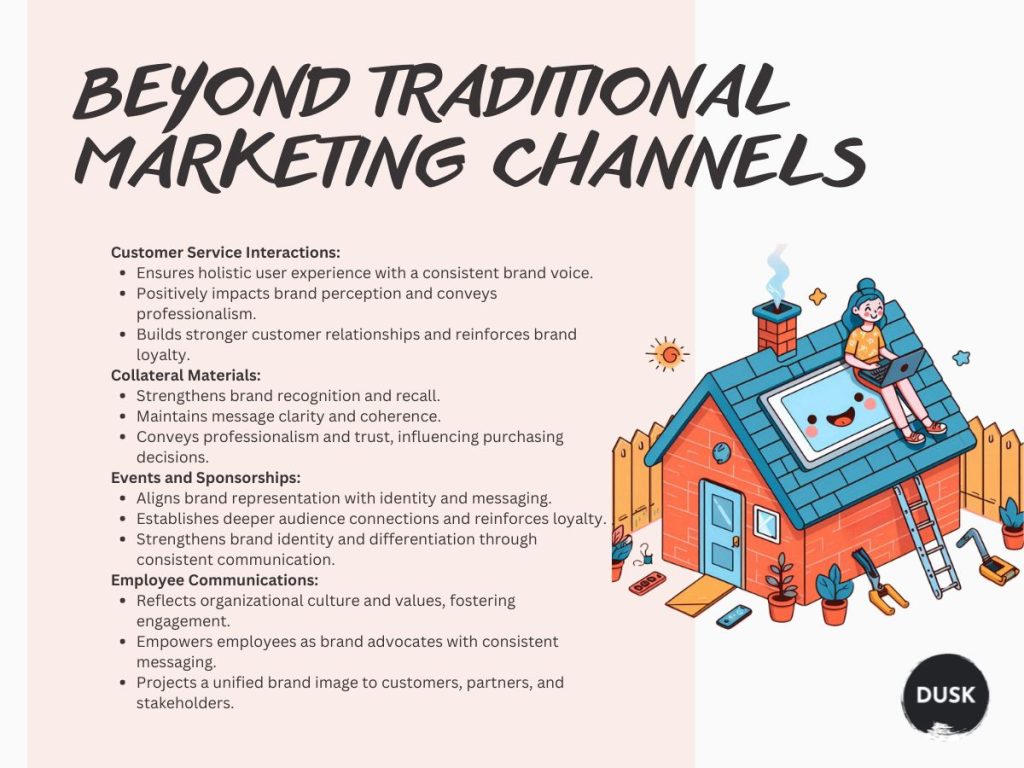In the bustling world of marketing, standing out is tough. But there’s one secret weapon that can make all the difference: your brand voice. You might have heard about it before, but we’re here to dive deeper and show you how to truly unlock its power.
Think about it like this: your brand voice is the personality of your business. It’s how you talk to your customers, whether it’s on your website, in emails, or even when they call for help. But here’s the thing – it’s not just about what you say, but how you say it.
In this blog, we’re going beyond the basics. We’ll explore how your brand voice can show up in unexpected places, like customer service and even employee communications. We’ll talk about why it’s crucial to keep evolving your voice as your business grows. And most importantly, we’ll give you practical tips on how to make sure your brand voice is consistent, authentic, and unforgettable.
Beyond Traditional Marketing Channels
In today’s marketing landscape, brand voice extends beyond websites and social media. Less conventional arenas like customer service, collateral materials, events, and employee communications also demand consistency.

Customer Service Interactions
Customer service interactions are often the frontline of customer engagement and satisfaction. Whether it’s a phone call, a live chat, or an email exchange, every interaction provides an opportunity to reinforce your brand’s values and personality. Here’s why it’s important to maintain a consistent brand voice in customer service:
- Holistic User Experience: Consistency in brand voice across customer service channels ensures a seamless and positive experience for users. It helps in building trust and loyalty by reinforcing the brand’s identity at every touchpoint.
- Brand Perception: Customer service interactions directly impact how customers perceive your brand. A consistent brand voice conveys professionalism, reliability, and authenticity, fostering a positive brand image.
- Relationship Building: By embodying the brand’s voice in customer interactions, representatives can establish rapport and build stronger relationships with customers. Consistent communication fosters familiarity and reinforces brand loyalty over time.
Collateral Materials
Collateral materials encompass a wide range of tangible assets, including brochures, flyers, product manuals, and packaging. While they may not receive as much attention as digital channels, these materials are essential for conveying information and shaping brand perception. Here’s why maintaining a consistent brand voice in collateral materials is crucial:
- Brand Recognition: Consistency in brand voice ensures that collateral materials align with the overall brand identity, making them instantly recognizable to customers. This consistency strengthens brand recall and reinforces key messaging.
- Message Clarity: Collateral materials serve as valuable resources for communicating product features, benefits, and brand values. A consistent brand voice helps in maintaining clarity and coherence, making it easier for customers to understand and connect with the brand.
- Professionalism and Trust: Well-designed and consistently branded collateral materials convey professionalism and attention to detail. This consistency instills trust in the brand and its offerings, influencing purchasing decisions and brand loyalty.
Events and Sponsorships
Events and sponsorships provide unique opportunities for brands to engage with their target audience in a more personalized and experiential manner. Whether it’s hosting a corporate event, sponsoring a community initiative, or participating in a trade show, maintaining a consistent brand voice is essential. Here’s why:
- Brand Representation: Events and sponsorships offer platforms for brands to showcase their personality, values, and offerings to a captive audience. Consistency in brand voice ensures that these representations align with the brand’s identity and messaging.
- Audience Connection: By incorporating the brand’s voice into speeches, signage, promotional activities, and other event materials, brands can establish a deeper connection with attendees. Consistent communication reinforces brand loyalty and encourages engagement.
- Reinforcement of Brand Identity: Events and sponsorships provide opportunities to reinforce key brand messages and values in a tangible and memorable way. Consistency in brand voice across these touchpoints strengthens brand identity and differentiation, making a lasting impression on attendees.
Employee Communications:
Internal communications play a critical role in aligning employees with the brand’s mission, values, and culture. From newsletters and memos to training materials and internal social platforms, every communication should reflect the brand’s voice. Here’s why it matters:
- Cultural Alignment: Consistency in brand voice ensures that internal communications reflect the organization’s culture and values. This alignment fosters a sense of belonging and purpose among employees, driving engagement and productivity.
- Brand Advocacy: Employees who understand and embody the brand’s voice become effective brand advocates both internally and externally. Consistent communication reinforces the brand’s messaging and empowers employees to represent the brand with confidence.
- Unified Brand Image: Internal communications shape external perceptions of the brand by influencing employee behavior and interactions. A consistent brand voice fosters coherence and authenticity, projecting a unified brand image to customers, partners, and stakeholders.
Alignment with Corporate Culture
In essence, a brand’s voice is the audible manifestation of its corporate culture. It encapsulates the ethos, values, and personality that define an organization. Here’s a closer look at why alignment with corporate culture is imperative:
- Authenticity and Trust: When employees embody the brand’s voice in their interactions, it fosters authenticity and builds trust among stakeholders. This alignment assures customers, investors, and partners that the brand is genuine and consistent in its beliefs.
- Employee Engagement: Embracing the brand’s voice empowers employees, fostering a sense of belonging and purpose within the organization. When individuals resonate with the brand’s values, they are more motivated to contribute positively to its growth and success.
- External Perception: Consistency between the brand’s voice and corporate culture projects a unified image externally. This coherence reinforces brand identity and strengthens connections with customers, who perceive the brand as transparent and reliable.
- Cultural Cohesion: By aligning with corporate culture, the brand voice becomes a unifying force within the organization. It serves as a common language that binds employees together, regardless of their roles or departments.
Evolution Over Time
Just as organizations evolve, so too should their brand voices. Adapting to changing market dynamics and consumer preferences is essential for maintaining relevance and resonance. Here’s why evolution over time is paramount:
- Market Responsiveness: By periodically reassessing and adjusting the brand voice, organizations can stay attuned to shifting market trends and emerging consumer needs. This agility allows them to remain competitive and seize new opportunities for growth.
- Brand Differentiation: Evolving the brand voice enables organizations to differentiate themselves in a crowded marketplace. By staying ahead of the curve and innovating in their communication strategies, brands can carve out a distinct identity that sets them apart from competitors.
- Customer Connection: A brand voice that evolves with the times demonstrates a commitment to understanding and meeting customer expectations. This adaptability strengthens the emotional connection between the brand and its audience, fostering long-term loyalty.
- Cultural Relevance: In a rapidly changing world, brands must stay culturally relevant to remain impactful. Evolving the brand voice ensures that it resonates with contemporary values and societal norms, keeping the brand in tune with the zeitgeist.
Training and Development:
Sustaining a consistent brand voice requires investment in the continuous training and development of employees. Equipping them with the necessary skills and knowledge ensures that the brand’s voice is consistently articulated across all touchpoints. Here’s why training and development are integral:
- Brand Advocacy: Well-trained employees become effective ambassadors for the brand, advocating its voice with confidence and conviction. Investing in their development fosters a culture of brand stewardship, where every individual takes pride in upholding the brand’s values.
- Consistency and Quality: Training ensures that employees understand the nuances of the brand voice and how to apply it appropriately in various contexts. This consistency in communication enhances the quality of interactions and reinforces the brand’s identity.
- Employee Engagement: Providing opportunities for training and development demonstrates a commitment to employee growth and professional advancement. Engaged employees are more likely to embrace the brand’s voice and contribute positively to its success.
- Continuous Improvement: Ongoing training enables organizations to adapt to evolving communication trends and best practices. By staying abreast of industry developments, employees can refine their skills and enhance the effectiveness of their communication efforts.
Monitoring and Evaluating Performance
Regular monitoring and evaluation of performance metrics are essential for gauging the effectiveness of brand voice strategies. By analyzing data and feedback, organizations can identify areas for improvement and optimize their approach. Here’s why monitoring and evaluating performance are crucial:
- Data-Driven Decisions: Performance metrics provide valuable insights into the impact of brand voice initiatives on key business objectives. By analyzing data, organizations can make informed decisions about resource allocation and strategy refinement.
- Identifying Gaps: Monitoring performance allows organizations to identify gaps or inconsistencies in brand voice implementation. By addressing these issues proactively, they can ensure a more cohesive and impactful communication strategy.
- Continuous Learning: Evaluating performance encourages a culture of continuous learning and improvement within the organization. By celebrating successes and learning from failures, teams can refine their approach and achieve greater effectiveness over time.
- Stakeholder Feedback: Soliciting feedback from stakeholders, including customers, employees, and partners, provides valuable insights into the perception of the brand voice. By incorporating this feedback into performance evaluations, organizations can make adjustments that better align with stakeholder expectations.
Conclusion
In the dynamic landscape of branding and communication, maintaining a consistent brand voice requires a multifaceted approach. By aligning with corporate culture, evolving over time, investing in training and development, and monitoring performance, organizations can ensure that their brand voice remains authentic, relevant, and impactful.
As the cornerstone of organizational identity, a consistent brand voice serves as a beacon that guides interactions, fosters connections and builds trust with stakeholders.






